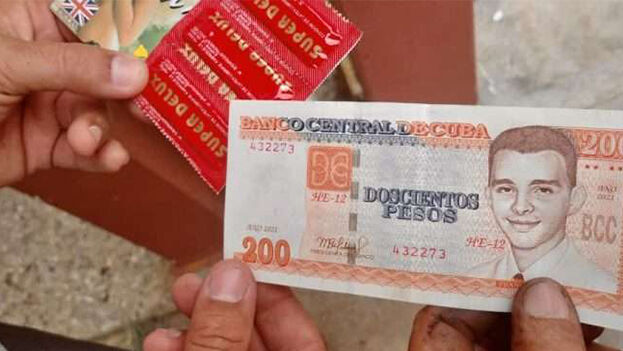
![]() 14ymedio, Havana, 12 May 2023 — The last batch of condoms destined for commerce and for Artemisa’s medical offices was received two years ago. Since then, the Directorate of Pharmacies and Opticians of the province recognizes in the local press that the supply has been limited only to the informal market, where Cubans can get the product at prohibitive prices.
14ymedio, Havana, 12 May 2023 — The last batch of condoms destined for commerce and for Artemisa’s medical offices was received two years ago. Since then, the Directorate of Pharmacies and Opticians of the province recognizes in the local press that the supply has been limited only to the informal market, where Cubans can get the product at prohibitive prices.
Sarah Varona Monzón, spokesperson for the Directorate, confirmed to the newspaper that since the first quarter of 2021 they have not received a single package of condoms, unlike contraceptive tablets, which do arrive at the offices and are delivered every 15 days to the municipalities.
“Before, when condoms came in, they were evenly distributed among all pharmacy units. That would be the same strategy if they came back,” the official says.
In the article entitled “Condoms in Cuba: Taking Care of Yourself or Not Taking Care of Yourself, That’s the Problem,” El Artemiseño recognizes the failure in the supply of contraceptive methods and says the informal market is the only alternative to avoid both sexually transmitted diseases (STDs) and unwanted pregnancies.
The cycle of contraceptive injections for a year usually costs 3,600 pesos [$150], while each condom is worth between 35 and 50 pesos [$1.45-2.00]. “Even if they’re more expensive, they’re worth paying for,” admits Mario Rodríguez, a 24-year-old man interviewed by the newspaper.
According to the newspaper, only the international pharmacy of Mariel, in Artemisa, has condoms at $2.40 in MLC (freely convertible currency) for a box of three, equivalent to 288 pesos [$12] in national currency at the official exchange rate or about 440 pesos [$18] in the informal market. Cubans “have no choice but to succumb to Facebook and WhatsApp groups that, these days, meet so many needs of everyday life,” he adds.
But not all Cubans can afford to pay the exorbitant prices of the informal market, and the media recognizes that the data on sexual diseases are not “good.” A report by the Artemis Public Health Directorate revealed that the HIV/AIDS epidemic has grown significantly since its inception in 1986. There was only a decrease in 2022 in diagnoses compared to the previous year, attributable to the fact that the search for cases was focused on the municipalities of Guanajay, Güira de Melena and Candelaria.
Young people between the ages of 20 and 24 are the “most affected” and represent 28.3% of the total number of patients diagnosed. Then there is the group from 25 to 29 years old, with 15.1%. The same percentage represents the confirmed cases of Cubans between the ages of 30 and 34. “The male sex continues to predominate in the epidemic, especially men who have sex with men (HSH), although, there are also cases of the female sex,” cites El Artemiseño.
The most contagious diseases are syphilis and gonorrhea. The report indicates that syphilis increased in all the municipalities of the province, although the highest incidence is recorded in the municipalities of Bahía Honda, San Cristóbal, Bauta and Artemisa. In this case, clinical pictures predominate among young people from 19 to 24 years old.
On the other hand, the infection rate of gonorrhea — also known as blennorrhagia — is 46.1 per 100,000 inhabitants. As with syphilis, the age groups with the most confirmed diagnoses are young people aged 19 to 24. In this case, the municipalities with the highest infections are Artemisa, Güira de Melena, Bahía Honda and San Cristóbal.
Contraceptive methods have become popular among the products that Cubans living abroad bring on their visits to the Island. The morning-after pill and intrauterine devices arrive many times with travelers, for their relatives or to resell them. A single morning-after pill costs between 700 and 900 pesos [$29-37.50] in the informal market.
Cuba also receives donations, but Lester Rojas Lay, provincial coordinator of the HSH Network, affirms that they are not enough for the needs of the population. They recently received a shipment of prophylactics aimed at the gay population from the Global Fund to Fight AIDS, Tuberculosis and Malaria.
“We are clear: we only give a sample because our mission is to educate in the use of protected sex. Everything would be easier if they were in the pharmacy,” said the coordinator, who explained that they only offer 21 condoms and 10 lubricants a year.
El Artemiseño adds that the “misfortune” of the shortage of condoms goes beyond diseases, since it is also the most effective method in the prevention of pregnancies. Similarly, he points out that Artemisa has very young pregnancy rates: 31% of women between 20 and 24 years old, followed by 16.6% of young people between 15 and 19 years old.
Finally, the newspaper doubts whether the high rate of pregnancies should be attributed only to the lack of condoms, since there is also a great “ignorance and unconsciousness of the act at such a young age” among artemiseños.
Translated by Regina Anavy
____________
COLLABORATE WITH OUR WORK: The 14ymedio team is committed to practicing serious journalism that reflects Cuba’s reality in all its depth. Thank you for joining us on this long journey. We invite you to continue supporting us by becoming a member of 14ymedio now. Together we can continue transforming journalism in Cuba.
